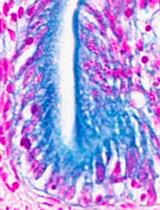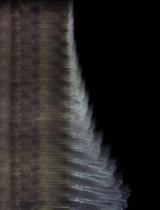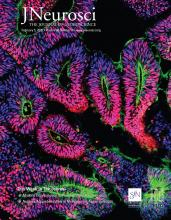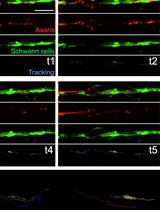- EN - English
- CN - 中文
Whole-mount Immunohistochemistry of Adult Zebrafish Retina for Advanced Imaging
用于图像采集的成年斑马鱼视网膜的整体免疫组化研究
发布: 2020年12月20日第10卷第24期 DOI: 10.21769/BioProtoc.3848 浏览次数: 5164
评审: Subhra Prakash HuiVictor Steven Van LaarMatthew Swire

相关实验方案

成年斑马鱼的整体衰老相关 β-半乳糖苷酶 (SA-β-GAL) 活性检测方案
Marta Marzullo [...] Miguel Godinho Ferreira
2022年07月05日 5324 阅读

通过免疫荧光定量非洲鳉鱼整体和再生尾鳍冷冻切片的细胞增殖
Augusto Ortega Granillo [...] Alejandro Sánchez Alvarado
2023年12月20日 2462 阅读
Abstract
Immunohistochemistry is a widely used technique to examine the expression and subcellular localization of proteins. This technique relies on the specificity of antibodies and requires adequate penetration of antibodies into tissues. The latter is especially challenging for thick specimens, such as embryos and other whole-mount preparations. Here we describe an improved method of immunohistochemistry for retinal whole-mount preparations. We report that a cocktail of three reagents, Triton X-100, Tween-20, and DMSO, in blocking and antibody dilution buffers strongly enhances immunolabeling in whole-mount retinas from adult zebrafish. In addition, we establish that in whole retinal tissues, a classic epitope retrieval method, based on citrate buffer, is effective for immunolabeling membrane-associated proteins. Overall, this simple modification allows precise and reproducible immunolabeling of proteins in retinal whole-mounts.
Keywords: Photoreceptor (感光器)Background
To understand complex biological processes, morphological and histological analyses allow for practical qualitative and quantitative approaches. Immunohistochemistry is a robust technique used to visualize the expression and localization of intra- and extra-cellular proteins. Although conventional histological sectioning offers high resolution images of immunostained proteins, sectioning 3-dimensional tissues results in poor preservation of tissue architecture. In sections, complete cellular structures and a complete understanding of the 3-dimentional distribution of proteins are not readily appreciated. In contrast, whole-mount preparations provide large volume 3D information, including intact cellular structures and the spatial relationships of cells and molecules in a complex tissue. However, adapting immunohistochemistry for use with intact tissues often results in poor permeability of antibodies, resulting in incomplete labeling, and a high degree of non-specific background.
In the retina, the cell body of the radial Müller glia spans the entire thickness of the retina (Bringmann et al., 2006). Microglia, the innate immune cells in the central nervous system, with a small cell body and ramified processes, are distributed throughout the retinal parenchyma (Li et al., 2015; Silverman and Wong, 2018). In response to neuronal damage or death, Müller glia and microglia undergo significant structural remodelling. Characterizing the morphology of these two cell types provides a readout the local environment surrounding each cell type and the overall health of the retina (Nagashima et al., 2020; Silva et al., 2020).
Detergents and organic solvents are common reagents that efficiently break down the permeability barriers of cells and nuclei (Jamur and Oliver, 2010). Triton X-100 and Tween-20 are widely used non-ionic detergents, which perturb the phospholipid bilayer structure of biological membranes (Kalipatnapu and Chattopadhyay, 2005; Koley and Bard, 2010; Cheng et al., 2019). Although dimethyl sulfoxide (DMSO), a polar organic solvent, or acetone, a common fixative,has been shown to enhance permeability of cell membranes (de Ménorval et al., 2012), its utility in immunohistochemical procedures is less common. Most procedures select a single reagent of detergents or solvents for permeabilization, and the efficiency of combining more than two chemicals is not well documented.
Here we describe an improved method of whole-mount immunohistochemistry. We report that a cocktail of three reagents, Triton X-100, Tween-20, and DMSO diluted in blocking and antibody dilution buffers dramatically enhances immunolabeling in whole-mount retinas. We also report that a classic citrate buffer based epitope retrieval method (Shi et al., 1993) is effective for immunolabeling membrane associate proteins. For completeness, we also include a detailed protocol for isolating whole retinas from zebrafish.
Materials and Reagents
Animals
Adult Zebrafish (Danio Rerio, Zebrafish International Resource Center, Eugene, OR, 4 to 12 months)
Materials
Colorfrost Plus Microscope Slides (Fisher Scientific, catalog number: 12-550-18 )
Cover Glass, Rectangle No. 1½, 24 x 50 mm (Corning, catalog number: 2980-245 )
1.5 ml Microcentrifuge Tubes, Free of detectable RNase, DNase, DNA & pyrogens (USA Scientific, catalog number: 1615-5500 )
1 ml Syringe without needle (BD, REF 309659 )
ProLong Gold Antifade Mountant (hard-set; ThermoFisher Scientific, catalog number: P36930 )
Reagents
Tissue preparation and fixationTricaine-S/MS-222 (Syndel, Ferndale, WA)
Sodium Bicarbonate (Sigma-Aldrich, catalog number: S5761-500G )
Paraformaldehyde (SPI Supplies, catalog number: 02615-AB )
Sodium Hydroxide/NaOH pellets (Sigma-Aldrich, catalog number: S-0899 )
Sodium Phosphate Monobasic Monohydrate/NaH2PO4·H2O (Millipore Sigma, catalog number: SX0710-3 )
Sodium Phosphate Dibasic/Na2HPO4 (Sigma-Aldrich, catalog number: S7907-1KG )
Sucrose (Sigma-Aldrich, catalog number: S9378-1KG )
10x Anesthesia/Tricaine stock solution (see Recipes)
Anesthesia/Tricaine working solution (see Recipes)
1.0% Sodium Bicarbonate solution (see Recipes)
40% paraformaldehyde stock (see Recipes)
4% paraformaldehyde in 0.1 M Phosphate buffer with 5% sucrose (see Recipes)
10x Phosphate Buffer stock (1.0 M, pH 7.4) (see Recipes)
0.1 M Phosphate buffer with 5% sucrose (see Recipes)
Sodium Citrate Dihydrate/C6H5Na3O7·2H2O (Fisher Scientific, catalog number: BP327-500 )
Tween 20 (Fisher Scientific, catalog number: BP337-500 )
Hydrochloric Acid/HCl (Fisher Scientific, catalog number: A144-500 )
Sodium Phosphate Monobasic Monohydrate/NaH2PO4·H2O (Millipore Sigma, catalog number: SX0710-3 )
Sodium Phosphate Dibasic/Na2HPO4 (Sigma-Aldrich, catalog number: S7907-1KG )
Sodium Chloride/NaCl (Sigma-Aldrich, catalog number: S7653 )
Potassium Chloride/KCl (Sigma-Aldrich, catalog number: P3911-500G )
Triton X-100 (Sigma-Aldrich, catalog number: T9284-500ML )
Sodium Azide (Sigma-Aldrich, catalog number: S2002-100G )
Dimethyl Sulfoxide (Sigma-Aldrich, catalog number: D8418-100ML )
Goat Serum Donor Herd (Sigma-Aldrich, catalog number: G6767-500mL )
Anti-mCherry antibody (rabbit polyclonal, Abcam, catalog number: 167453 )
Goat anti-Rabbit IgG (H+L) Highly Cross-Adsorbed Secondary Antibody, Alexa Fluor 647 (Invitrogen, catalog number: A21245 )
Mouse monoclonal anti-ZO1 (ThermoFisher Scientific, ZO1-1A12, catalog number: 33-9100 )
Goat anti-Mouse IgG (H+L) Cross-Adsorbed Secondary Antibody, Alexa Fluor 555 (Invitrogen, catalog number: A21422 )
Sodium Citrate Buffer (see Recipes)
10x Phosphate Buffered Saline (PBS, pH 7.4) stock (see Recipes)
PBS (see Recipes)
PBS with 0.5% Triton X-100 (see Recipes)
10x PBS with 1% sodium azide (see Recipes)
Whole-mount IHC blocking buffer (see Recipes)
Whole-mount IHC dilution buffer (see Recipes)
Whole-mount IHC washing buffer (see Recipes)
Equipment
Scissors, VANNAS, 8 cm STR (G) (World Precision Instruments, model: 14003-G )
Tweezers Dumont #5 INOX (World Precision Instruments, model: 501985 )
Leica 205FA Stereomicroscope (Leica Microsystems)
Fisher brand Isotemp Stirring Hotplate (ThermoFisher Scientific, model: SP88857200 )
Rocker
1,500 ml beaker (PYREX, model: CE-BEAK1L )
LidLocks Microcentrifuge Tube Locks (VWR International, model: 14229-941 )
Round Microcentrifuge Floating Bubble Rack (VWR International, model: 60-86-342 )
Spoon Knife, Double Bevel, Angled 3.3 Blade (Hilcovision, model: 625-0743061-06 )
15 ml Conical Tube (FALCON, model: 352097 )
Transfer Pipets (Fisher Scientific, model: 13-711-7M )
Injection Needle with LuerLok Syringe 1 ml 30G ½ (BD, model: 305778 )
Zeiss AxioImage ZI Epifluorescent Microscope (Carl Zeiss MicroImaging LLC)
Fisherbrand Nutating Mixers-Fixed speed (Fisher Scientific, model: 88-861-041)
Software
ImageJ
Adobe Photoshop CC 2019 (Adobe Systems)
Procedure
文章信息
版权信息
© 2020 The Authors; exclusive licensee Bio-protocol LLC.
如何引用
Readers should cite both the Bio-protocol article and the original research article where this protocol was used:
- Nagashima, M. and Hitchcock, P. F. (2020). Whole-mount Immunohistochemistry of Adult Zebrafish Retina for Advanced Imaging. Bio-protocol 10(24): e3848. DOI: 10.21769/BioProtoc.3848.
- Nagashima, M., D’Cruz, T. S., Danku, A. E., Hesse, D., Sifuentes, C., Raymond, P. A. and Hitchcock, P. F. (2020). Midkine-a is required for cell cycle progression of müller glia during neuronal regeneration. in the vertebrate retina. J Neurosci 40(6): 1232-1247.
分类
发育生物学 > 细胞生长和命运决定 > 再生
神经科学 > 发育 > 组织学染色
细胞生物学 > 细胞成像 > 固定组织成像
您对这篇实验方法有问题吗?
在此处发布您的问题,我们将邀请本文作者来回答。同时,我们会将您的问题发布到Bio-protocol Exchange,以便寻求社区成员的帮助。
提问指南
+ 问题描述
写下详细的问题描述,包括所有有助于他人回答您问题的信息(例如实验过程、条件和相关图像等)。
Share
Bluesky
X
Copy link










